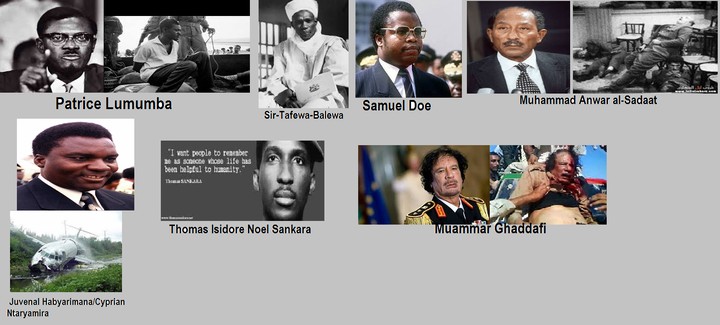
Up until recent times not many African countries could boast of any kind of political stability and order with respect to change of government. The squabble for power and control plagued many states, and newly independent states, lacking any previous experience of democracy or self-rule were worst hit. Also, with sit-tight leadership being the fashion in those days, opponents of a regime have had to resort to the use of force and violence to oust unpopular or unwanted dictators. Over the decades past, quite a number of African leaders have been taken off power violently. This piece attempts to capture the most notable of such events, selected based on historical significance and aftermath events, and listed in reverse chronology.
1. Patrice Lumumba (DR Congo, 1961)
For many Congolese, the assassination of their First Prime Minister in 1961 marked the beginning of the end of what was supposed to be a new era of freedom, peace and prosperity following independence in 1960. Following elections, Patrice Lumumba was announced Prime Minister in June 1961 at the age of 34. He endured a tumultuous tenure plagued by the Congo Crisis, which comprised of mutiny in the Army, secession of important mineral-rich regions-Katanga and South Kasai-with Belgian support, rebellion in some parts of the country, and inter-ethnic fights.
After failing to get the support of the US and the UN in fighting the secession, Lumumba turned to the Soviets-a cardinal sin in the era of the cold war. This led to division within his own government and his subsequent deposition by Army Chief, Joseph Mobutu (a.k.a Mobutu Sese Seko).
Patrice Emery Lumumba was executed by firing squad on January 17 1961. According to Wikipedia, his body was dug up and ‘dissolved in sulfuric acid while the bones were ground and scattered’.
2. Sir Abubakar Tafawa Balewa (Nigeria, 1966)
The Assassination of Nigeria’s first and last Prime Minister, in 1966 amongst other political figures sparked off a series of sad events that culminated in a very brutal three-year civil war, which in itself, is a subject for another time. As with many leaders of new African states, Balewa had a tumultuous reign as Prime Minister with regional factionalism (especially from the ‘wild, wild west’), electoral violence, political and ethnic unrest giving his government a hard time. When on 15 January 1966, a group of officers struck against the political class assassinating amongst prominent politicians, Sir Balewa was top of the hit list.
Nicknamed the ‘Golden Voice of Africa’ due to his oratory, Balewa spoke impeccable (and Hausa accent spiced) English. His decent education, oratory, humility, Spartan lifestyle and little regard for the goodies of office makes him revered by many, till this day.
The exact manner of Balews’s death remains uncertain. What is certain, however, is that he was abducted from his official residence on 15 January 1966 and was missing for days. Many historical accounts hold that his body was found days later on the outskirts of Lagos, bullet-ridden and at an advanced stage of decomposition. His remains was laid to rest in Bauchi.
3. Muhammad Anwar al-Sadaat (Egypt, 1981)
Egypt’s ‘Hero of War and Peace’ and ‘Master of the Dramatic’ assumed power in 1970 following the death of Popular Arab leader, Gamal Abdel Nasser to whom he was a Vice-President. Born on Christmas day in 1918, Sadaat was that little son of a peasant farmer who would become one of the most charismatic leaders of his era.
As a young soldier, he was part of the ‘Free Officers’, a clique in the Egyptian Army instrumental to the overthrow of the Monarchy of King Farouk. As president, Sadaat is best known for his surprise 1973 ‘October War’ with Israel which weakened Israeli control over the Sinai Peninsular-a part of Egypt it had captured in the 1967 war, his unprecedented trip to Israel to ‘talk peace’ in November 1977 and his eventual peace deal with the State of Israel-the Camp David accords of 1979, which saw Egypt reclaim the Sinai Peninsula.
Sadaat was a man of oratory, charm, style and swagger with a knack for risk taking even with the possibilities of potential political cost. Muhammad Anwar al-Sadaat was assassinated at a Military parade in 1981 by a group of officers who were discontent about the Peace deal with Israel, worsening economy, imprisonment of opposition figures, among other things.
4. Samuel Doe (Liberia, 1990)
Samuel Doe’s assassination was gruesomely remarkable. It was not your regular sniper-take-down or firing squad assassination. It was arguably the first time that the world would watch a sitting head-of-state stripped down to his underpants, interrogated and humiliated before being dispatched to the great beyond in pieces.
Then Master-Sergeant Doe took power as a 28-year old Army officer also murdering incumbent, William Tolbert. Days later, members of Tolbert’s cabinet (except, among a few others, Ellen Johnson Sirleaf-Current President- who luckily escaped) were summarily and publicly executed at a beach in Monrovia. Doe ruled from April 1980 to September 1990 when he was captured by forces loyal to rebel leader, Prince Johnson. He died after hours of torture at the hands of Johnsons men.
Considering the circumstances of his ascension to power, not a few disagreed that he didn’t deserve his eventual fate.
5. Juvenal Habyarimana/Cyprian Ntaryamira (Rwanda/Burundi, 1994)
On the evening of 6 April 1994, a Dassault Falcon 50 airplane was shot down as it approached Kigali International Airport for a stopover enroute Bujumbura, Burundi. In the flight were Rwandan President, Juvenal Habyarimana and Burundian President, Cyprian Ntaryamira. Habyarimana’s death escalated already heated up Hutu/Tutsi ethnic tensions in a country where tribal identity and allegiance meant everything and could solely determine one’s chances of survival. This sparked off the Rwandan genocide of 1994 which saw almost a million Tutsis and moderate Hutus massacred to death within a space of four months.
Habyarimana’s death is still a subject of controversy in Rwanda. One version-the official version-has it that the plane was taken down by Hutu extremists desperate for an excuse to wipe out Tutsis, another version holds Tutsi fighters (allegedly led or ordered by Paul Kagame-current President) responsible.
Habyarimana, a Hutu, served from 1973 to 1994.
6. Thomas Isidore Noel Sankara (Burkina Faso, 1987)
It is said that ‘your best friend could be your worst enemy’, and that was the fate of young, vibrant, charismatic and straight-talking Thomas Sankara. After taking power in 1983 through a coup, Sankara became widely popular for his progressive ideals and for the zeal with which he sought to attain them. He put his country on the path of self-reliance and real economic independence and pursued reforms that encouraged local production and less reliance on foreign aid. His reforms impacted the lives of the citizenry and instilled in them the spirits of patriotism and hope which he demonstrated in his words and actions.
Sankara was assassinated in a coup in 1987, which many believed to be backed by the same Western imperialists Sankara sought to turn away from. The coup leader was a certain Blaise Campaore, Sankara’s ‘right hand man’, childhood friend, academy course mate and Army colleague.
Perhaps, you should take the popular expression, “watch your back” more seriously.
7. Muammar Ghaddafi (Libya, 2011)
When in 2009, the Brotherly Leader of the Libyan people marked his 40th year in office, few had reasons to believe he won’t be around for much longer. Ghaddafi overthrew King Idris, Libya’s last monarch, in 1969 to establish a modern Libyan state which he would preside over for the next four decades plus. A most eccentric, stylish and controversial figure, Colonel Ghaddafi transformed Libya from a traditional monarchy and one of Africa’s poorest states, to a truly modern state with the highest human development indices ratings on the continent in terms of Per Capita Income, Life expectancy and Literacy rate and Girl-child education.
Like many African leaders however, he had strong dictatorial tendencies. Press freedom and democratic structures were practically non-existent with reports of human-right abuses.When the Arab spring of 2010-2011 flowed into Libya, clashes between government and opposition forces led to a NATO intervention in favour of the latter. After months of bitter fighting, rebel forces eventually took control of Tripoli, the capital, effectively ending Ghaddafi’s 42- year reign.
As Ghaddafi fleed Libya, a satellite call made from his convoy was intercepted by NATO forces, resulting in air strikes. Colonel Ghaddafi was subsequently captured and killed (possibly by rebel forces).







